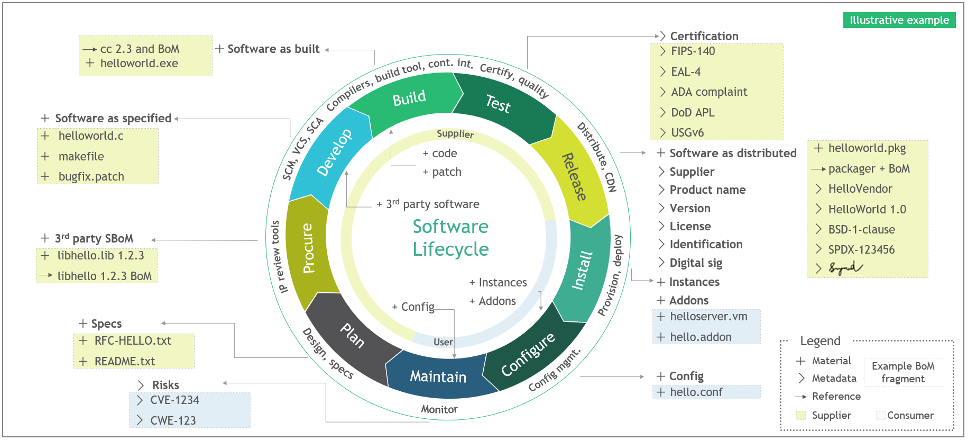
The digital world has witnessed some significant security incidents like the Log4J and MOVEit attacks, highlighting the need for robust cybersecurity practices. Software Bill of Materials (SBOMs) is emerging as a crucial tool in preventing such attacks. In this enhanced article, I will explore how SBOMs could have been instrumental in mitigating or even preventing these specific attacks.
Understanding the Log4J and MOVEit Attacks
Before diving into the role of SBOMs, it’s essential to understand the nature of these attacks. The Log4J vulnerability was a severe security flaw in a popular Java logging library, exposing countless applications to potential exploitation. Similarly, the MOVEit attacks involved vulnerabilities in a widely used file transfer software, posing risks to data integrity and security. Ultimately, these vulnerabilities led to large breaches of ePHI/PII as well as sensitive government information and more.
How SBOMs Could Have Helped
1. Early Detection of Vulnerabilities
With an SBOM, organizations using the affected software could have quickly identified their exposure to the Log4J and MOVEit vulnerabilities. An SBOM would list the specific versions of Log4J and MOVEit being used, enabling IT teams to rapidly assess their risk and prioritize their response.
2. Accelerated Response and Patch Management
In the case of Log4J and MOVEit, time was of the essence. An SBOM would have allowed for quicker identification of systems using these vulnerable components, leading to faster patching and updates. This rapid response could have significantly limited the window of opportunity for attackers.
3. Improved Supply Chain Risk Management
Both Log4J and MOVEit attacks are stark reminders of the risks associated with third-party components in software products. SBOMs provide visibility into the entire software supply chain, enabling organizations to assess and mitigate risks associated with each component. This visibility is crucial in preventing similar attacks.
4. Enhanced Compliance and Reporting
Following these attacks, regulatory bodies and clients might demand information on the affected components and the organization’s response. An SBOM offers a ready-made, comprehensive report of the components in use, simplifying compliance and reporting processes.
5. Building a Culture of Security Awareness
The implementation of SBOMs fosters a culture of security awareness within an organization. By regularly reviewing and updating SBOMs, organizations stay vigilant about their software components, which in turn helps in preventing not just known vulnerabilities like Log4J and MOVEit, but also emerging threats.
Overall
The Log4J and MOVEit incidents serve as a wake-up call for organizations to reassess their cybersecurity strategies. SBOMs emerge as a key tool in this context, offering numerous benefits from early detection of vulnerabilities to enhanced supply chain risk management. As a technologist, I advocate for the widespread adoption of SBOMs. In an age where software vulnerabilities can have far-reaching impacts, having a detailed inventory of software components is not just beneficial, it’s essential for the security and resilience of any organization.
Still Not Sure Where To Start? Check Out These Tools:
1. FOSSA
FOSSA is a leading tool for open-source management and compliance. It offers comprehensive SBOM generation capabilities, enabling organizations to identify open-source and third-party components in their codebase. FOSSA’s detailed audit reports and license compliance checks make it a go-to tool for companies looking to manage their open-source usage proactively.
2. Black Duck by Synopsys
Black Duck is a well-known solution in the realm of software composition analysis. It specializes in identifying open-source components in your software, checking for security vulnerabilities, and generating detailed SBOMs. Its extensive vulnerability database and policy enforcement capabilities make Black Duck an essential tool for secure software development.
3. WhiteSource
WhiteSource offers a robust platform for securing and managing open-source software components. It automates the entire process of SBOM generation, vulnerability detection, and compliance tracking. WhiteSource integrates seamlessly with a wide range of development tools, making it a versatile choice for modern DevOps environments.
4. Tidelift
Tidelift takes a slightly different approach by providing a subscription service that includes SBOM generation, along with maintenance and security for open-source dependencies. It helps organizations ensure that their open-source components are up-to-date, secure, and compliant with licensing requirements.
5. Dependency-Track
Dependency-Track is an open-source tool specifically designed for Component Analysis and SBOM generation. It supports Software Package Data Exchange (SPDX) and CycloneDX, two of the leading standards for SBOM formats. This tool is particularly useful for organizations looking to integrate SBOM generation into their existing DevOps processes.
6. JFrog Xray
JFrog Xray provides robust scanning of binary components, including containers and software artifacts, to identify vulnerabilities and license compliance issues. It generates detailed SBOMs and integrates with the JFrog Artifactory, offering a comprehensive solution for artifact management and security.